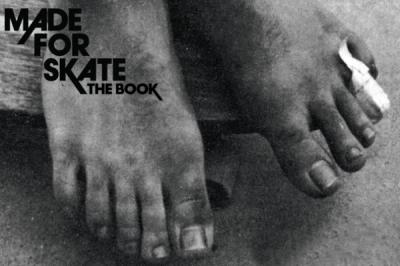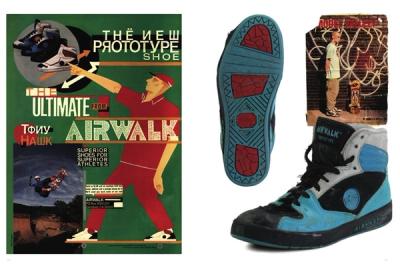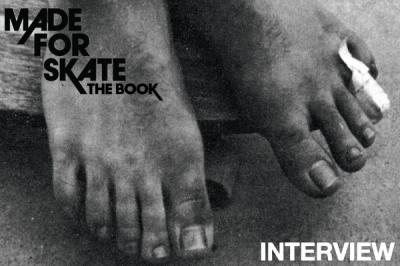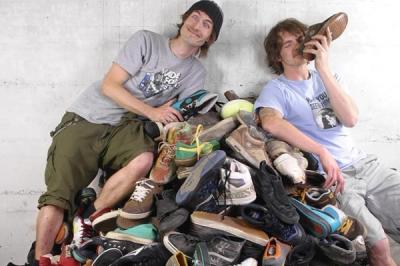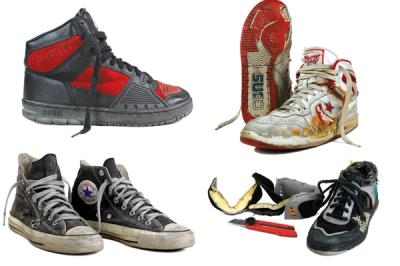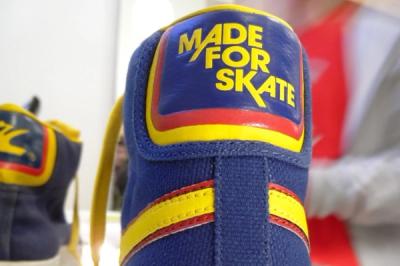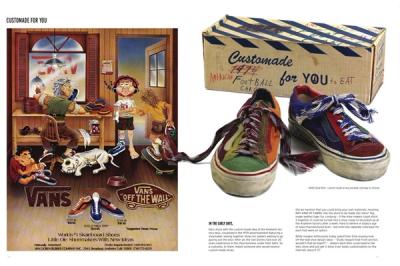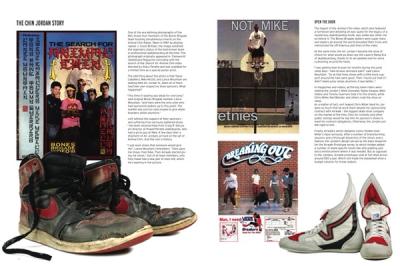Made For Skate - The Book Interview
We’ve known this book was coming since Issue 12, but we were still not prepared for how fucking awesome it is. In fact, we’re jealous like Tonya Harding. We wish we had made this book! Seriously. Featuring pics from SkateBoarder mag, Randy’s 720 shoe ads, every Vans image you ever dreamed of as well as tight info on curiosities such as Wilson, Hang Ten, Makaha and Hobies, it is impossible to think that anyone will ever attempt to make another 400 page tome on this subject. Add a great section on the last decade’s shenanigans with Nike SB and the new wave of skate brands and you can leave it right there. Even if you never skated one inch in your life, you need this book! Now here's an interview with the two authors...
You gave us a hint last time we spoke but how long did it take to get this amazing encyclopedia of skate footwear together?
The whole idea started after the first Made for Skate exhibition which we did at the Bright tradeshow in Frankfurt, 2007. A lot of people were asking us for a catalogue and we started thinking. Soon we realised that 100 pages would be much too limited to cover the whole subject in an adequate way. So we decided to go for a book. After collecting more and more shoes, shooting hundreds more pictures, doing a number of interviews and laying it all out, one and a half years had passed until we could send the ‘final’ file to the printer.
How did you convey the essence of an exhibition into a book?
The most significant difference is that you have way more options laying out a book than you get with real exhibits. They are the size they are in an exhibit and you can’t scale them or show a particular detail of a shoe. Of course, there is always a hundred ways to set up an exhibition, but you are not tempted to drag the shoes, text panels and advertisement around the wall that much as you would do on your screen. Within a few movements and clicks you get a total different result. That can be both a blessing and a curse. The content of the book had to cover the whole spectrum of our collected shoes and the advertisements we gathered, the same way as the exhibitions. Covering the historically important shoes, issues and topics of footwear and skateboarding itself.
One of the essential parts of our exhibitions is the way we integrate the topic (in this case skateboard shoes) into the flow of skateboard history in general. For example board shapes, skate fashion, ideologies and trends in the scene. For the research we used our extensive collection of skateboard magazines. The information, background knowledge and advertisements were used to create text panels to accompany the exhibits. We then transformed this information into a flowing text, for which our writer Dirk Vogel was responsible. His work for several European skateboard magazines and the fact that he’s got a university degree in the English language made him the perfect person for this part of the book. He brilliantly managed to break down complete decades into four pages of text to convey an experience to those that may not have seen it first hand, with what was going on, in and around the Skateboard world. So the quality of a ‘3D exhibition’ could be perfectly transferred into a ‘2D Exhibition’.
How hardcore did you wanna make the book?
The main focus was aimed at those that had a love for skateboarding or an emotional bond to thrashed skate shoes and the models from their early skateboarding days. From flicking through the book, those people are going to recall their personal experiences, stories and tricks they learned or certain people they met. We soon realized through our exhibitions that the subject was also intriguing for people who just love shoes or fashion and maybe once in their life were also related to skateboarding in one way or another.
The ‘newcomer kid’ who just started skateboarding will get an overview of the last 50 years of skateboarding, not just related to shoes but also what happened around them. So it is more an unintentional side effect that the interest group is so diversified. We certainly didn’t try to explain what an Ollie is…
Any difficulties getting the vintage advertisements or shoes featured in the book?
For the advertisements and the shoes, eBay was a big help. A lot of the old magazines could be found there (not all of them affordable though) and many of the ‘70s ‘freak shoes’ came direct from the global flee-market that is eBay. To be sure we didn’t miss anything crazy, funny or important advertisement-wise, we even traveled to a guy in Holland (Niko) who’s supposed to have almost every issue of every Skateboard magazine, stored and sorted properly in a warehouse! It was an amazing (and exhausting) experience to flip through thousands of pages of vintage Skate mags we had never seen before. At the end we wanted to sleep with a clear conscience that we really tried the best we could to find every necessary piece of info. We needed to be certain that we really did have the first Vans ad ever published in a Skateboard magazine (because we checked them all!) and also finding proof of what was the first skateboard shoe ever.
Did you also get every single shoe you wanted?
No way, there is never going to be enough pages to really cover all the important parts and pieces that have played a role in the history of skateboard footwear. For sure it would have been great to get a pair of Randy’s 720°, to really have an original picture of the first Skateboard shoe ever in the book. As is always the case, curiosities reached out to us right after we already finished all the printing data. One of them was the ALVA shoe, from which only two pairs exist which we now have in the MFS exhibition but sadly not in the book!
There is also a fair chunk of background text and written content to complement the images. Who did you call on to contribute?
Everybody we ever met through the years since we started the Skateboard museum contributed in their own way. Many pro-skaters from all over the globe, shoe designers and company heads helped out. But most importantly, it all came down to the one guy who ‘brought it all to life’ and made sense of everything; our writer Dirk Vogel. Sometimes it was really hard to understand the answers of the people we did interviews with. Maybe also because of the way we put the questions. Who knows? But Dirk really did a great job putting all the bits and pieces together to create the text, which is absolutely essential for the book!
You’ve said in the past that ‘there is no soul in new shoes’ and now you have the evidence to back that up. What do the skate shoes you feature say about the lifestyle and what it has become?
If you look at all the pages dedicated to the roots – seventies, eighties and mid-nineties you will not find shoes that were created for a purpose other than skateboarding. When the first limited edition shoes were produced for skateboarding, the purpose of skateboard shoes took on a new direction. For sure there were people buying themselves an extra pair of KCKs from Duffs to keep them deadstock because they loved the model. But the shoes were not produced in runs of only 100 for example, to give collectors something to get crazy about. This was the most obvious change, then there were more and more people matching their whole outfit around the colors of the board graphic, wheels or grip tape or vice versa.
The quote at the front of the book, ‘Trashed shoes are like a war wound, evidence of how hard you skate, not something to be embarrassed about’ says a lot about where the OG skaters were coming from back in the day. By paying homage to a side of the sneaker culture that a lot of collectors and newbies are ignorant to, do you hope to change people’s minds about beaters?
We don’t want to change anybody’s mind, just show the world how and for what purpose the shoes were once designed. The collection craze changed that for sure. ‘Made for storage’ is not the idea behind a skateboard shoe. Maybe for people who like to collect those things it is, but they have to stand the test on the ‘battlefield’, not just on the shelf, looking good. To skate in one of those ‘highly collectible sneakers’ is really a lot of fun (if they actually work for skateboarding) because people will say ‘Man, are you crazy? Do you know what they cost on eBay?’ and you’re just like ‘No, but they’re really great for skateboarding!’ We call it contrast to the crazy hype.
You guys are now on your promotional tour on the east coast of the US. Do you hope to expand the tour to other sectors of the world including down under? You know we have a massive skate scene down here!
Yeah, for sure we want to eventually travel to the other side of the planet too! So far we’ve only scheduled to go to three cities in the US this year and for 2010 we will be thinking about some exhibitions in Australia and Asia. It takes a lot of preparation work to get everything cleared with customs, shipping and finding the right location.
When and where can peeps pick up ‘Made for Skate – The Illustrated History Of Skateboard Footwear’?
In any bookstore or museum shops, hopefully the local skate shop and online at . If some bookstore or skate shop doesn’t have it, tell them to order it for you from our publisher
Thanks fellas!
